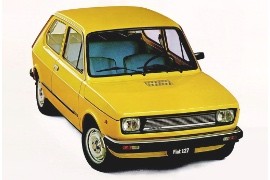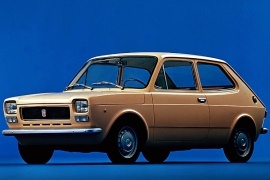FIAT 127 Models/Series Timeline, Specifications & Photos
First production year: 1971
Engines: Gasoline
Body style: Hatchback
Fiat introduced a refreshed version of its supermini model 127 in 1977, and besides some stylistic changes, it also came with a sport version.
When the Italian automaker introduced the 127 in the late '60s, it was surprised by the car's success on the market. Thanks to the innovative solutions adopted, such as the transversely-mounted engine, it became a hit on the European market. In addition, the car was licensed for other countries such as Poland and Yugoslavia. So, even though it was about time to be replaced, the automaker kept building it until 1981.
After the mid-70s, the automakers started to introduce plastic wrap-around bumpers on their cars to make them more aerodynamic and also to comply with safety standards. Thus, the 127 received a new front fascia. Its turn signals were moved from under the headlights into the bumper for a sleeker look. Another significant change was at the rear, where the car finally received a tailgate instead of a separate trunk lid that opened without the rear window, as in the first series.
Inside, the 127 provided plenty of legroom for front passengers thanks to the transversely-mounted engine. That solution allowed the automaker to move the seats forward so the rear occupants could get better legroom in the back as well. In addition, since it was already a hatchback, Fiat installed a flat-folding rear bench instead of the fixed one on its predecessor.
Under the hood, the automaker kept the 0.9-liter powerplant from its predecessor and added a 1.0-liter option that provided up to 70 PS (69 hp).
By the end of the '60s, Fiat was selling well in Europe, and it tried to keep that momentum with new cars. While the 124 was more or less a reworked 1300, the 127 was a completely new vehicle.
The Italian carmaker already saw the customers' interest in hatchback vehicles, such as the Renault 16 or the BMW 1600. It also knew that it had to replace the aging 850 lineup, and for that, it prepared the 127. A front-engine, front-wheel drive small-segment hatchback that was a far better concept than its predecessor.
Customers didn't want the rounded shapes of the 850 or the 600 models. The increasing sales of the boxier 124 confirmed that. Thus, the Italian carmaker penned the 127 with flatter surfaces, more angles, and, moreover, squared headlights. Meanwhile, in the U.S., the carmakers were still forced to design cars with round headlights. But since that didn't apply to the 127, and the car was not shipped across the Atlantic, Fiat could do it as he liked it. Behind the short engine compartment, a raked, curved windshield paved the way for a small greenhouse that protected the cabin from elements. At the back, the sloped tailgate was the essence of the hatchback design, with a wide and tall opening that left the rear panel in place. True, the loading and unloading were difficult, but the customers liked it, especially since the rear seats could fold flat.
The interior could accommodate up to four passengers, with improved comfort than in the cramped 850 model. Obviously, since it was a mass-market car, it was available with a four-speed manual only. Thanks to its small, 0.9-liter engine, the car managed to achieve an outstanding fuel efficiency for those times.

